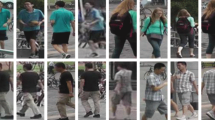Abstract
The problem of tracking people in a video stream with the aim of counting them is studied. Modern video surveillance systems, such as the Moscow video surveillance system, use hundreds of thousands of cameras. The use of modern methods developed for working on a single computer with an expensive graphical processor is economically inefficient for such large-scale systems. In this paper, a distributed tracking algorithm is proposed. It makes it possible to reduce the amount of computational resources due to detecting people in a sparse set of frames. The detection is performed on servers installed in a data center, while the video stream is processed by local camera computation nodes. The experimental evaluation showed that the proposed algorithm provides acceptable quality at the detection rate of 4/3 Hz.







Similar content being viewed by others
Explore related subjects
Discover the latest articles, news and stories from top researchers in related subjects.REFERENCES
Fillipov, I.V. et al., Counting people in a video sequence based on detecting the head of each person, Program. Producty Sist., 2015, no. 1, pp. 121–126.
Bewley, A., Ge, Z., Ott, L., Ramos, F., and Upcroft, B., Simple online and realtime tracking, Comput. Vision Pattern Recognit., 2016. arXiv:1602.00763 [cs.CV]
Fengwei, Y., Wenbo, L., Quanquan, L., Yu, L., Xiaohua, S., and Junjie, Y., Poi: Multiple object tracking with high performance detection and appearance feature, European Conference on Computer Vision, Springer, 2016, pp. 36–42.
Wojke, N., Bewley, A., and Paulus, D., Simple Online and realtime tracking with a deep association metric, Comput. Vision Pattern Recognit., 2017. arXiv:1703. 07402 [cs.CV]
Shu, G. et al. Part-based multiple-person tracking with partial occlusion handling, IEEE Conference on Computer Vision and Pattern Recognition, 2012, pp. 1815–1821.
Benfold, B. and Reid, I., Stable multi-target tracking in real-time surveillance video, IEEE Conference on Computer Vision and Pattern Recognition, 2011, pp. 3457–3464.
Shalnov, E., Konushin, V., and Konushin, A., An improvement on an MCMC-based video tracking algorithm, Pattern Recognit. Image Anal., 2015, vol. 25, pp. 532–540.
Kuplyakov, D., Shalnov, E., and Konushin, A., Markov chain Monte Carlo based video tracking algorithm, Program. Comput. Software, 2017, vol. 43, no. 4, pp. 224–229.
Choi, W., Near-online multi-target tracking with aggregated local flow descriptor, Comput. Vision Pattern Recogn., 2015. arXiv:1504.02340 [cs.CV]
Kuhn, H.W., The Hungarian method for the assignment problem, Naval Res. Logistics, 1955, vol. 2, no.1/2, pp. 83–97.
Lenz P., Geiger A., and Urtasun, R., FollowMe: Efficient online min-cost flow tracking with bounded memory and computation, IEEE International Conference on Computer Vision (ICCV), 2015.
Shalnov, E.V., Konushin, A.S., and Konushin, V.S., Convolutional neural network for camera pose estimation from object detections, ISPRS – International Archives of the Photogrammetry, Remote Sensing and Spatial Information Sciences, 2017, vol. 42, pp. 1–6.
Shalnov, E.V. and Konushin, A.S., Using scene geometry to improve detector accuracy, Program. Producty Sist., 2017, vol. 30, no. 1, pp. 106–111.
Ren, S. et al., Faster R-CNN: Towards real-time object detection with region proposal networks, Advances in Neural Information Processing Systems, 2015, pp. 91–99.
Kristan, M. et al., The Visual Object Tracking VOT2016 challenge results, 2016. http://www.springer. com/gp/book/9783319488806
Vojir,T., Noskova, J., and Matas, J., Robust scale-adaptive mean-shift for tracking, Scandinavian Conference on Image Analysis, Springer, 2013, pp. 652–663.
Milan, A. et al., MOT16: A benchmark for multi- object tracking. http://arxiv.org/abs/1603.00831
Funding
This work was supported by the Russian Foundation for Basic Research, project no. 16-29-09612 ofi_m Study and Development of Methods of Biometric People Identification by Gait, Gestures, and Bodily Constitution in Video Images.
Author information
Authors and Affiliations
Corresponding authors
Additional information
Translated by A. Klimontovich
Rights and permissions
About this article
Cite this article
Kuplyakov, D.A., Shalnov, E.V., Konushin, V.S. et al. A Distributed Tracking Algorithm for Counting People in Video. Program Comput Soft 45, 163–170 (2019). https://doi.org/10.1134/S0361768819040042
Received:
Revised:
Accepted:
Published:
Issue Date:
DOI: https://doi.org/10.1134/S0361768819040042




